The family Oriolidae is comprised of the Figbirds in the genus Sphecotheres, and the Old World Orioles in the genus Oriolus. The family is distributed across Africa, Europe, Asia, and Australia. It is not related to the New World orioles, which belong to family Icteridae.
The orioles and figbirds are medium sized passerines, around 20–30 cm in length, with the females only slightly smaller than the males. The beak is slightly curved and hooked. The plumage of most species is bright and showy, although the females often have duller plumage than the males do. Orioles are arboreal and tend to feed in the canopy. They are opportunistic omnivores, with the main components of their diet being fruit, berries, and arthropods. The nest is a deep woven cup suspended like a hammock from a branch.
Genus Oriolus
Oriole,_African_Golden Oriolus auratus Found: Africa
The African Golden Oriole has mainly yellow plumage; solid black on flight feathers and tail center. Female has much of the yellow replaced with greenish-yellow.
Image by: 1, 2) Charlie Westerinen - Zimbabwe 3) Josh_More 4) Sandy
Cole - San Diego Zoo
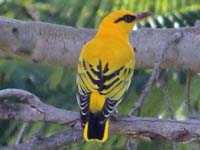
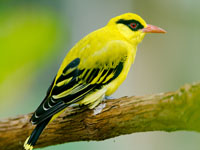

Oriole, Black Oriolus hosii Found: Borneo
The Black Oriole has mainly black plumage; red rump.
Image by: 1) John_Gerrard_Keulemans 2) Michelle_and_Peter_Wong

Oriole,_Black-and-Crimson Oriolus cruentus Found: Indonesia, Malaysia
The Black-and-Crimson Oriole has mainly black plumage; crimson lower-breast, upper-belly. The Black Oriole, Black-and-Crimson Oriole, Maroon Oriole, and Silver Oriole belong to a clade.
Image by: 1) John_Gerrard_Keulemans 2) Rabbot 3) Nathan_Rupert - San Diego Zoo 4) Francesco_Veronesi - Malaysia 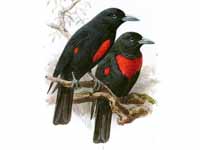
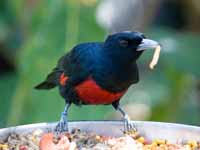
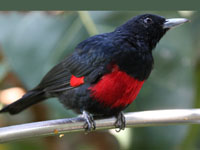

Oriole, Black-eared also Buru Oriole Oriolus bouroensis Found: Indonesia
Image by: 1) Michael_Poulsen

Oriole,_Black-headed also African Black-headed Oriole Oriolus larvatus Found: Africa
The Black-headed Oriole has mainly yellow plumage; black head; flesh colored bill.
Image by: 1`, 3) Derek_Keats - South Africa 1) Jo Mur - Naboomspruit 4)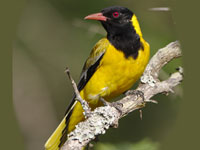

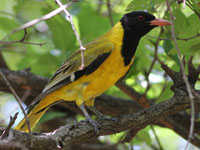
Oriole,_Black-hooded Oriolus xanthornus Found: southern Asia
The male Black-hooded Oriole has mainly yellow plumage; black hood; black in wings; black tail center. Female is drabber. Has black hood; greenish underparts.
Image by: 1, 2, 3) J. M. Garg in Kolkata,
West Bengal, India 4) Vijay_Ismavel
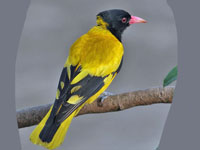
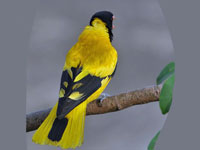

Oriole,_Black-naped Oriolus chinensis Found: south Asia
The Black-naped Oriole has mainly yellow plumage; black mask continues to nape. Female has much of the yellow replaced with greenish-yellow.
Image by: 1, 3) J. M. Garg 2) Johnny Wee 4) Dick Daniels - San Diego Zoo 5) Melvin_Yap - Singapore1) Juvenile





Oriole,_Black-tailed also Mountain Oriole Oriolus percivali Found: Burundi, DR Congo, Kenya, Rwanda, Tanzania, Uganda
The Black-tailed Oriole has black hood, wings, upper-tail coverts; rest yellow.
Image by: 1) Francesco_Veronesi - Kenya 2) Steve_Garvie - Kenya

Oriole,_Black-winged Oriolus nigripennis Found: Africa
Image by: 1) John_Gerrard_Keulemans 2) Francesco_Veronesi - Ghana 3) Nik_Borrow - Caneroon


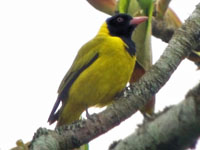
Oriole, Brown Oriolus szalayi Found: New Guinea
The Brown Oriole has medium-brown upperparts; paler on head; heavliy streaked with black on head; buff underparts.
Image by: 1) Jerry_Oldenettel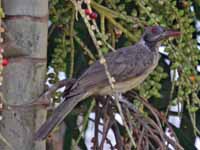
Oriole, Dark-throated Oriolus xanthonotus Found: southeast Asia, Indonesia, Malaysia, Philippines
Image by: 1) Lip Kee - Java 2) Ramon_Quisumbing 3) Wong_Tsu_Shi
1) Female

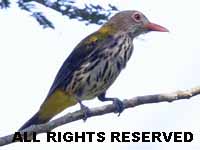

Oriole, Dusky-brown Oriolus phaeochromus Found: Northern Maluku of Indonesia
Image by: 1) Paulo_Alves 2) Peter_Ericsson


Oriole, Ethiopian also Ethiopian Black-headed Oriole Oriolus monacha Found: Eritrea, Ethiopia
Image by: 1) P_Khoo 2) James_St_John 3) Nik_Borrow - Ethiopia
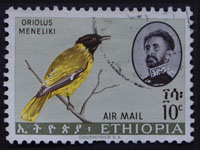

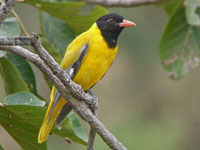
Oriole,_Eurasian_Golden Oriolus oriolus Found: Europe (breeding ), Asia (nonbreeding)
The male Eurasian Golden Oriole has black and yellow plumage; thick black eye-line. Female has green upperparts; yellow underparts.
Similar to: Indian Golden Oriole. Male Indian Golden Oriole has paler red in iris and bill than Eurasian Golden Oriole. It also has black eye-line extending behind the eye. Female Indian Golden Oriole has sharper streaks on underside than Eurasian Golden Oriole.
Image by: 1) Victor_Kravichenko 2) Paco Gómez 3) Agustin_Povedano 4) Michel_Idre 5) Kookaburra_81 - France Agustin_Povedano - SpainSimilar to: Indian Golden Oriole. Male Indian Golden Oriole has paler red in iris and bill than Eurasian Golden Oriole. It also has black eye-line extending behind the eye. Female Indian Golden Oriole has sharper streaks on underside than Eurasian Golden Oriole.
2) Female 3, 4) Male
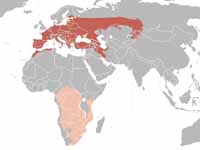

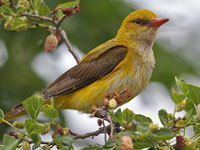
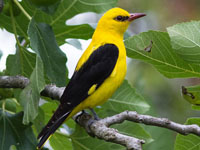

Oriole, Gray-collared also Seram Oriole Oriolus forsteni Found: souther Maluku Islands of Indonesia
Image by: 1) Ron_Huff - Seram, Indonesia
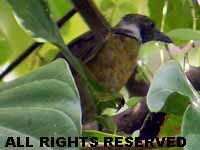
Oriole,_Green also Australasian Yellow Oriole Oriolus flavocinctus Found: Australian, New Guinea
Image by: 1) Katerina_Tvardikova 2, 3) Geoff_Whalan - Northern Territory Francesco_Veronesi
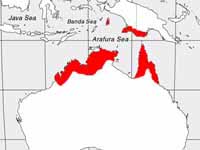


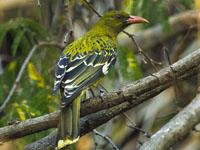
Oriole,_Green-headed Oriolus chlorocephalus Found: Africa
Image by: 1) John Gerrard Keulemans 2) Dick Daniels - specimen in Nairobi National Museum, Kenya 3) Maans_Booysen - Mozambique



Oriole, Indian Golden Oriolus kundoo Found: Indian subcontinent and central Asia
The male Indian Golden Oriole has black and yellow plumage; thick black eye-line. Female has green upperparts; whitish underparts with dark stripes.
Similar to: Eurasian Golden Oriole. Male Indian Golden Oriole has paler red in iris and bill than Eurasian Golden Oriole. Female Indian Golden Oriole has sharper streaks on underside than Eurasian Golden Oriole.
Image by: 1, 2) JM_Garg - India 3) Swardeepak 4) Imrun_Shah - PakistanSimilar to: Eurasian Golden Oriole. Male Indian Golden Oriole has paler red in iris and bill than Eurasian Golden Oriole. Female Indian Golden Oriole has sharper streaks on underside than Eurasian Golden Oriole.


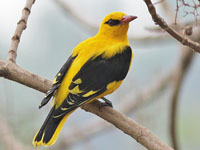

Oriole, Isablea Oriolus isabellae Found: Luzon in Philippines
The Isablea Oriole is close to extinction.
Image by: 1) Merlijn_van_Weerd
Oriole,_Maroon Oriolus traillii Found: India, southeast Asia
The male Maroon Oriole has mainly glossy crimson-maroon plumage; black head, neck, wings. Female has grayish-white underparts with black streaks.
Image by: 1) Jerry_Oldenettel - Thailand 2, 3) Hiyashi_Haka 4) Ainus - Taiwan1) Female 2, 3) Male
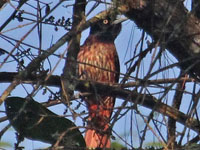


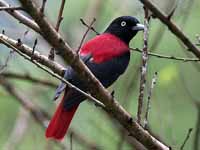
Oriole,_Olive-backed Oriolus sagittatus Found: Australia, New Guinea
Image by: 1) Katerina_Tvardikova 2) Duncan McCaskill 3) Brian_McCauley 4) patrick kavanagh - Victoria 5) Charlie Westerinen - Rockhampton


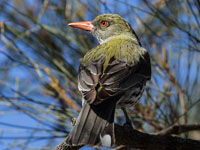


Oriole,_Olive-brown also Timor Oriole Oriolus melanotis Found:Lesser Sundas islands of Indonesia
Image by: John Gerrard Keulemans 2) James_Eaton
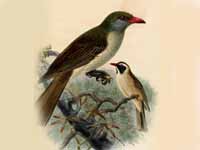

Oriole, Philippine Oriolus steerii Endemic to Philippines
The Philippine Oriole has yellowish-brown upperparts; gray throat, breast; white belly with black stripes; red bill, eyes. Some consider subspecies White-lored Oriole (Oriolus steerii albiloris) to be a separate species. It is found on Masbate and Negros islands.
Image by: 1) John Gerrard Keulemans 2) Blake_Matheson

Oriole,_Sao_Tome Oriolus crassirostris Found: Sao Tome (off west coast Africa)
Image by: 1) Henrik_Gronvold 2) Alexandra 3) Muchaxo
2) Juvenile


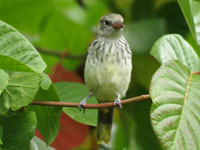
Oriole, Silver Oriolus mellianus Found: Cambodia, China, Thailand
Image by: 1) Wichyanan_Limparungpatthanak - Thailand 2) Thiti_Tanaree - Thailand
1) Female 2) Male


Oriole,_Slender-billed Oriolus tenuirostris Found: Asia
Image by: 1) P_Khoo 2) Michael_Gillam 3) Jainy_Kuriakose 4) Jerry_Oldenettel - Thailand
1) Juvenile



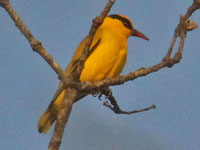
Oriole, Tanimbar Oriolus decipiens Found: Tanimbar Islands (Indonesia)
Image by: 1) Jon_Hornbuckle

Oriole, Western also Western Black-headed Oriole Oriolus brachyrynchus Found: Central Africa
The Western Oriole has yellow-olive upperparts; yellow underparts.
Image by: 1) John_Gerrard_Keulemans 2) Arthur Grosset 3) Francesco_Veronesi
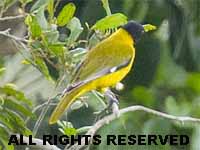
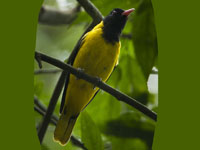
Genus Pitohui
These Pitohui are all native to New Guinea. They are among the few known poisonous birds, containing a range of batrachotoxin compounds in its skin, feathers and other tissues. These toxins are thought to be derived from their diet, and may function both to deter predators and protect the bird from parasites.
Pitohui,_Hooded Pitohui dichrous Found: New Guinea
The Hooded Pitohui has rufous-chesnut; upperparts; black head, neck, bib, upper-wing; chestnut-rufous remainder underparts.
Image by: 1, 2, 3) Katerina_Tvardikova 4) Nik_Borrow

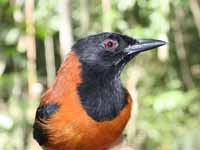

Pitohui,_Variable Pitohui kirhocephalus Found: New Guinea
The Variable Pitohui dark reddish-brown upperparts; gray head, throat; ferruginous underparts.
Some split the Variable Pitohui into the Northern Variable Pitohu (Pitohui kirhocephalus)i, Southern Variable Ptiohui (Pitohui uropygialis) , and Raja Ampat Pitohui (Pitohui cerviniventris).
Image by: 1, 2) Katerina_TvardikovaSome split the Variable Pitohui into the Northern Variable Pitohu (Pitohui kirhocephalus)i, Southern Variable Ptiohui (Pitohui uropygialis) , and Raja Ampat Pitohui (Pitohui cerviniventris).

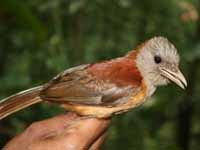
Genus Sphecotheres
These three figbird species were formerly considered conspecific.
Figbird, Australasian also Figbird Sphecotheres vieilloti Found: Australia, Papua New Guine, Kai Islands in Indonesia
The male Australasian Figbird has olive-green or yellowish olive-green upperparts; black crown; red facial skin; black bill with red base; gray neck, breast (nominate subspecies) or bright yellow. Female has dull brown upperparts; white underparts with strong dark streaking.
Image by: 1) Katerina_Tvardikova 2) Cyron Ray Macey 3) Dick
Daniels 4) Aviceda 5) Charlie Westerinen - Tweed, Australia 6) Arthur_Chapman - Queensland 7) Michael Jefferies - Queensland2) Juvenile 3) Female 4 - 7) Male
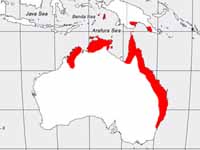




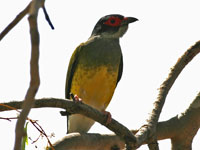

Figbird, Green also Timor Figbird Sphecotheres viridis Found:Indonesian islands of Timor and Roti
The Green Figbird is just found on the islands of Timor and Roti.
Image by: 1, 2) James_Eaton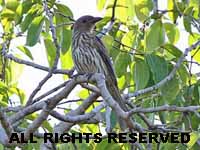

Figbird, Weter Sphecotheres hypoleucus Found: island of Wetar of Indonesia
Image by: 1, 2) Colin_Trainor

